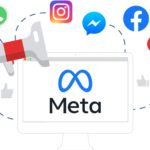In the fast-paced digital landscape, reaching the right audience at the right time is no longer a luxury—it’s a necessity. That’s where Meta Ads step in. With billions of users across Facebook, Instagram, Messenger, and the Audience Network, Meta Ads Course in Urdu offers an unparalleled platform for marketers to connect, convert, and grow. Whether you’re a beginner or a seasoned advertiser, understanding the essentials of Meta Ads can significantly boost your digital marketing success.
What Are Meta Ads and Why Do They Matter?
Meta Ads refer to the advertising tools provided by Meta (formerly Facebook) that allow businesses and marketers to create, manage, and optimize ads across its family of apps. These include Facebook, Instagram, Messenger, and the Audience Network.
What makes Meta Ads so valuable is the rich user data the platform offers. With advanced targeting capabilities based on demographics, interests, behaviors, and even recent online activity, Meta enables advertisers to deliver tailored content to highly specific audiences. This precision helps increase engagement, drive conversions, and reduce wasted ad spend.
Setting Up Your Meta Ads Account
Before you can run campaigns, you need to set up your Meta Business Manager. This centralized platform allows you to manage ad accounts, Pages, assets, and user roles. Once your Business Manager is ready, you can create an ad account and connect it to a Facebook Page and Instagram profile.
Make sure to install the Meta Pixel on your website. This small piece of code tracks user interactions, helping you retarget visitors, optimize campaigns, and measure ad performance effectively.
Understanding the Meta Ads Structure
Meta Ads operate on a three-level structure: Campaign, Ad Set, and Ad.
Campaign: At the top level, you choose the objective of your ad campaign. Meta offers various objectives like awareness, traffic, engagement, leads, app installs, sales, and more.
Ad Set: This is where you define your audience, budget, schedule, placements, and bidding strategy. It’s crucial to test different audiences and placements to find the best-performing combinations.
Ad: At the ad level, you create the actual content—text, images, videos, headlines, call-to-action buttons, and links. High-quality creatives aligned with your message and target audience are key to success.
Choosing the Right Campaign Objective
Selecting the right campaign objective is critical. Meta’s algorithm optimizes delivery based on your goal, so pick the one that aligns with your business outcome.
Brand awareness: Use this if your goal is to get your brand in front of more people.
Traffic: Ideal for driving users to your website or app.
Engagement: Focuses on getting likes, comments, shares, or event responses.
Leads: Great for generating form submissions or messages.
Conversions: Best when you want users to take a specific action, like buying a product.
Each objective unlocks different optimization options, so understanding your end goal helps guide the campaign setup.
Crafting Effective Ad Creatives
Visuals play a crucial role in Meta Ads performance. Here are a few tips to make your ads stand out
Use high-quality images or videos that reflect your brand and resonate with your audience
Keep text minimal and impactful—grab attention quickly
Use compelling headlines and clear calls to action
Test multiple variations to see which combination delivers the best results
Remember, Meta prioritizes ads that offer a good user experience. Avoid overly promotional language and focus on providing value.
Targeting the Right Audience
One of the biggest strengths of Meta Ads is its targeting capabilities. You can reach people based on
Demographics like age, gender, location, and language
Interests such as hobbies, brands followed, and lifestyle
Behaviors like purchase activity, device usage, and travel habits
Custom audiences created from your website visitors, email list, or app users
Lookalike audiences based on your existing customers or leads
The more precise your targeting, the better your chances of reaching users who are likely to convert. However, don’t narrow your audience too much—let Meta’s machine learning find the best people within your parameters.
Budgeting and Bidding Strategies
Meta Ads offer flexible budgeting options. You can choose between daily and lifetime budgets, and either manual or automatic bidding.
Start small and scale as you gather data
Use automatic bidding if you’re unsure about what to pay per result
Monitor performance and adjust budgets accordingly
Use A/B testing (split testing) to experiment with different creatives, audiences, and ad placements without blowing your budget
With proper testing and optimization, you can achieve strong ROI even with modest budgets.
Monitoring and Optimizing Campaigns
Launching your ads is just the beginning. Monitor performance through Meta Ads Manager to track key metrics such as
Reach and impressions
Click-through rate (CTR)
Cost per result
Conversion rate
Return on ad spend (ROAS)
Use these insights to pause underperforming ads, scale successful ones, and tweak targeting or creatives. Optimization is an ongoing process that turns good campaigns into great ones.
Staying Updated with Meta’s Evolving Features
Meta regularly updates its ad platform with new features, tools, and policies. Staying informed is essential for maintaining performance and compliance. Subscribe to Meta’s official blog, join digital marketing communities, and keep experimenting with new formats like Reels Ads, Advantage+ shopping campaigns, and AI-driven creative tools.
Conclusion
Mastering Meta Ads is a journey, not a one-time setup. With its powerful targeting, diverse ad formats, and scalable budget options, Meta offers modern marketers everything they need to run effective digital campaigns. Whether you aim to build brand awareness, generate leads, or drive sales, knowing how to navigate Meta Ads is essential in today’s marketing world.

